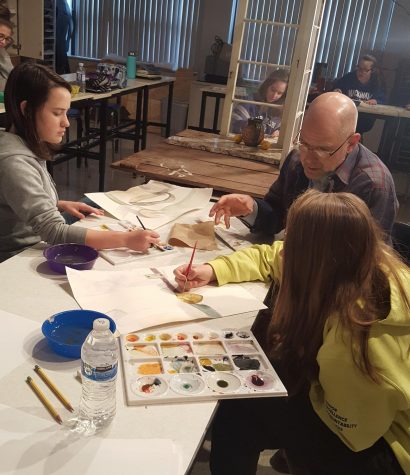The Importance of Art Education
Electives broaden, enrich student experience
February 4, 2019

It’s February–time to decide which classes you’ll be taking next year. There’s room in your schedule for two electives and you’re unsure of what to choose. You meet with your guidance counselor to narrow down your options, yet all they seem to suggest is an AP class, a foreign language, or an internship–whatever looks best on college applications.
But what about that fashion class you wanted to take? Or that drawing class? Or maybe even that digital design one?
While Carroll offers a plethora of art classes–ranging from painting to fashion to interior design–they are often overlooked by “more important” classes. Once students have completed their two art credits, they’re encouraged to take AP classes instead of continuing in the arts. Once seniors have taken their four core classes, they’re encouraged to leave for the ICE program or an internship.
“But what are they giving up?” said CHS art teacher Mr. Kilmer. “They’re giving up the electives. And not just art, but all the electives. We’re whole people. We’re not just a math, science, and writing person.”
There is one main difference between an art class and social studies or math class. One concept that can’t be taught in those core classes: creativity. Through the creative outlet of art, students learn that life isn’t a Scantron. A, B, C, and D aren’t the only solutions to problems they may face.
In Kilmer’s advanced art classes, he refrains from answering all his students’ questions. He encourages them to think through their challenges and come to their own conclusions. He also purposefully designs assignments so that each student can interpret and answer the prompt in their own way, allowing all of them to be successful.
“If through the arts we can teach kids to problem solve and be creative, that’s going to separate them,” said Kilmer. “The people that are creative–that think outside the box–are going to be the innovators of the future.”
If you can’t figure out your math homework, you find the solutions online. If that Shakespeare you read in English class doesn’t make sense, you read the No Fear Shakespeare translation. It doesn’t work that way in art. You can’t Google creativity.
“With our world changing so fast from a technology standpoint, everything is at your fingertips,” Kilmer said. “It’s so easy to find the answer to everything. What’s going to separate people in the future? Creativity.”
According to Americans for the Arts, 72 percent of business leaders say that creativity is the number one skill they are looking for when hiring. Yet creativity is also the number one skill being brushed over.
From politicians to school counselors, art is continually being pushed to the side. And it’s not just at Carroll. It is a nationwide issue that needs to be addressed.
So when you go down to your guidance counselor seeking advice, remember to consider your own interests. Don’t settle for that AP class just because it is appealing to colleges. Give that art class that you’ve always wanted to take a try.
“Teaching young people how to solve problems and be creative is important,” Kilmer said. “It’s unfortunate that society still sees math, science, and reading as so overwhelmingly important. It is, obviously, but creativity is right there on an equal playing field. We need to embrace that and foster that.”